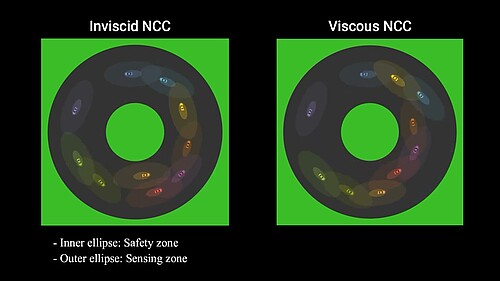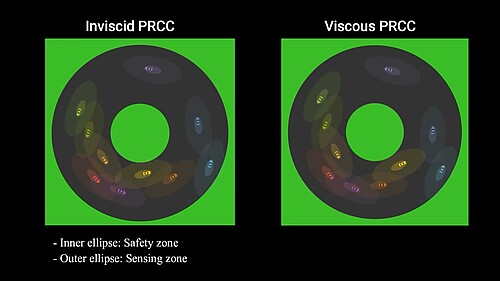Video Playlist 14: Cruise controllers for lane-free ring-roads
The videos included in this playlist show instances of autonomous vehicles operating on a lane-free ring-road and are part of the examples discussed in the paper entitled "Cruise controllers for lane-free ring-roads based on control Lyapunov functions". In this work, two families of cruise controllers are designed though Control Lyapunov Functions expressed on measures of the energy of the system. If the kinetic energy is expressed in a fashion similar to that of Newtonian mechanics, we call the corresponding controller a Newtonian Cruise Controller (NCC); while, when the kinetic energy is expressed in terms similar to that of relativistic mechanics, we call the corresponding controller a Pseudo-Relativistic Cruise Controller (PRCC). Each vehicle determines its control input based only on its own state and either only the distance from adjacent vehicles (inviscid cruise controllers) or the state of adjacent vehicles (viscous cruise controllers); and its distance from the boundaries of the ring-road. The goal of each vehicle is to achieve a fixed desired angular speed, while avoiding collisions with other vehicles. In particular, the proposed framework guarantees that vehicles do not collide with each other or with the boundary of the ring-road; the speeds of all vehicles are always positive and remain below a given speed limit; and all vehicle speeds converge to a given angular (desired) speed set-point. In addition, the inner ellipse around each vehicle describes a safety zone where no other vehicle can enter; and the outer ellipse around each vehicle denotes its sensing zone.
Lane-free ring-road with NCC
This video shows the application of cruise controllers for autonomous vehicles operating on lane-free ring-roads. The proposed cruise controller is called Newtonian Cruise Controller (NCC) since its design is based on measures of the energy of the system with the kinetic energy expressed in a fashion similar to that of Newtonian mechanics. Each vehicle determines its control input based only on its own state and either only the distance from adjacent vehicles (inviscid NCC) or the state of adjacent vehicles (viscous NCC); and its distance from the boundaries of the ring-road.
The inner ellipse around each vehicle describes a safety zone where no other vehicle can enter. The outer ellipse around each vehicle denotes its sensing zone, namely, each vehicle uses real-time measurements from other vehicles within its sensing radius.
This framework guarantees that vehicles do not collide with each other or with the boundary of the road; the speeds of all vehicles are always positive and remain below a given speed limit; and all vehicle speeds converge to a given angular speed set-point.

Lane-free ring-road with PRCC
This video shows the application of cruise controllers for autonomous vehicles operating on lane-free ring-roads. The proposed cruise controller is called Pseudo-Relativistic Cruise Controller (PRCC) since its design is based on measures of the energy of the system with the kinetic energy expressed in a fashion similar to that of relativistic mechanics (the kinetic energy increase to infinity when the vehicle’s speed approaches the maximum allowed speed – instead of the speed of light). Each vehicle determines its control input based only on its own state and either only the distance from adjacent vehicles (inviscid PRCC) or the state of adjacent vehicles (viscous PRCC); and its distance from the boundaries of the ring-road.
The inner ellipse around each vehicle describes a safety zone where no other vehicle can enter. The outer ellipse around each vehicle denotes its sensing zone, namely, each vehicle uses real-time measurements from other vehicles within its sensing radius.
This framework guarantees that vehicles do not collide with each other or with the boundary of the road; the speeds of all vehicles are always positive and remain below a given speed limit; and all vehicle speeds converge to a given angular speed set-point.

